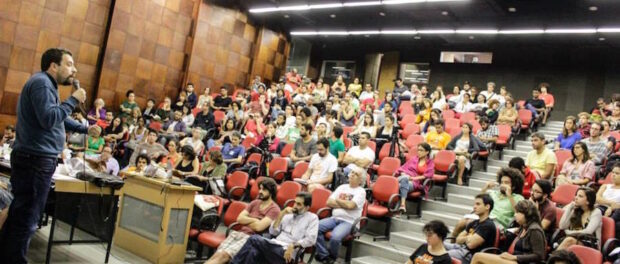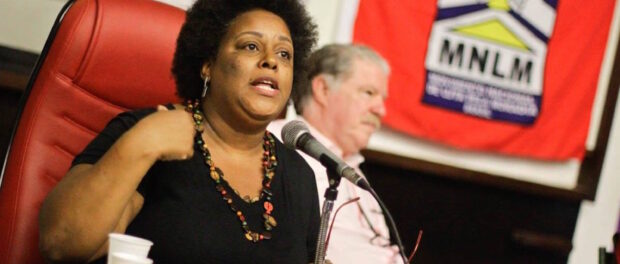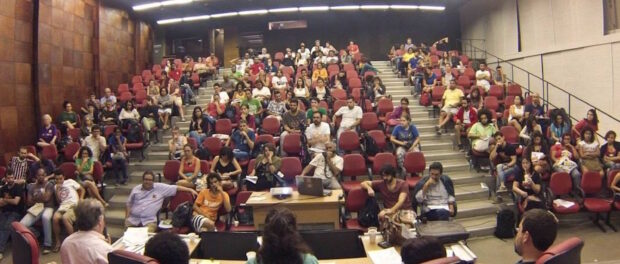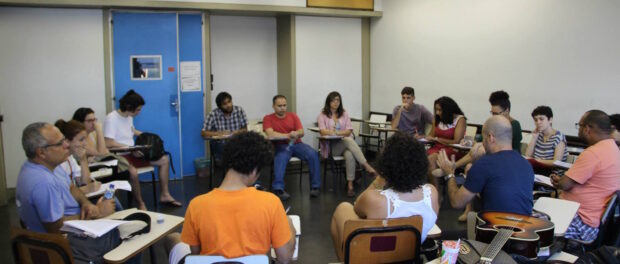
Around 150 people gathered on Saturday August 1 at the State University of Rio de Janeiro (UERJ) to launch Viver Na Cidade (Living in the City), a series of events sponsored by the group Se A Cidade Fosse Nossa (If The City Were Ours). This group is committed to promoting active participation and citizenship in the city. Its Living in the City series will consist of “cyclical themed seminars and neighborhood meetings” that work alongside online platforms with the intention of creating meaningful participatory planning.
“We dream of a Rio de Janeiro that is more free, supportive and happy,” read the packet handed out at the event. “Therefore, our objective is to create a popular mobilization strategy to overcome the current model of the city. Our proposal is to build a network of actions, large and cross-sectoral policies to promote social and environmental justice, popular participation and defend the freedoms of those who are oppressed.”
The discussion series will explore what problems the city is facing on a micro level—the neighborhood level. Neighborhoods like Santa Teresa have already held smaller events to talk specifically about issues residents face there.
The launch event featured a panel discussion to introduce these goals of the Living in the City series. Panelists included UERJ social services professor Isabel Cardoso, urbanist Carlos Vainer, Borel resident and representative of the Borel Institutions Network Monica Francisco, and Guilherme Boulos of the Homeless Worker’s Movement. The discussion began with passionate statements from the panelists about how their own lives and work relate to the purpose of the meeting series.
“It has always been signaled to us, the inhabitants of the favelas and suburbs, that the city has never belonged to us. But we know and understand that the favela is a part of the city; we cannot separate one from the other. Currently, the city has been transformed into a financial capital object of desire. We of the favela have difficulty relating to this model city. There is a growing distancing of black men and women in the city. The real picture of who is being removed and dying in the urban space is clear: they are young, black men and women, and residents of peripheral areas of the city,” remarked Francisco.
“If the city were ours, we would be living and not dying,” she continued. “We’re talking about lives and people who are suffering a real impact of distance and not belonging in the city. It is important to bring the perspectives of favelas and suburbs to the housing debate. This is an everyday disaster in people’s lives, resulting in the deaths of people. We need to think about how we can, in a practical way, save lives.”
Vainer and Boulos explained why so much conflict arises between the city’s public and private interests, especially involving the city’s poorer residents.
“The city is open for business…the process of production and appropriation of wealth. While for us, the city is a collective and public space,” stated Vainer.
Boulos said: “The real estate boom, spurred by financial interests, generated a new periphery. When a neighborhood begins to be [financially] valued, there is an expulsion of those who can no longer afford the exorbitant prices of rents. This results in a process of segregation and expulsion, which pushes out the poor population.”
After the panel discussion, attendees divided into five different focus groups titled: The Favela is the City; Center, Suburbs and Periphery; Memories and Identities; Around Town; and Social Justice.
The Favela is the City group focused on developing creative ideas to better integrate favelas into the city, while still recognizing the diversity among favelas. Discussions centered on how to better lobby policymakers like the Municipal Secretary of Housing to respond to favela needs like sanitation, education and basic healthcare. The group worked to formulate a long-term vision, which will be published on the If The City Were Ours website, along with the work produced by the other groups.



